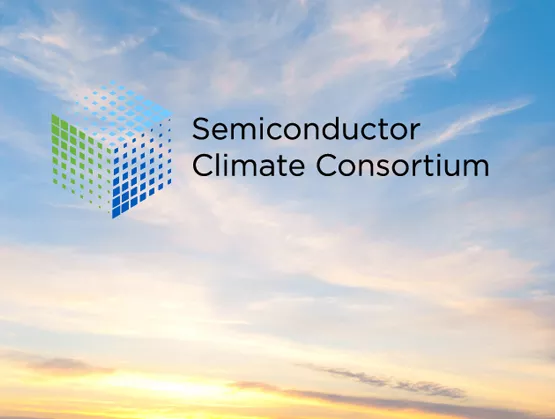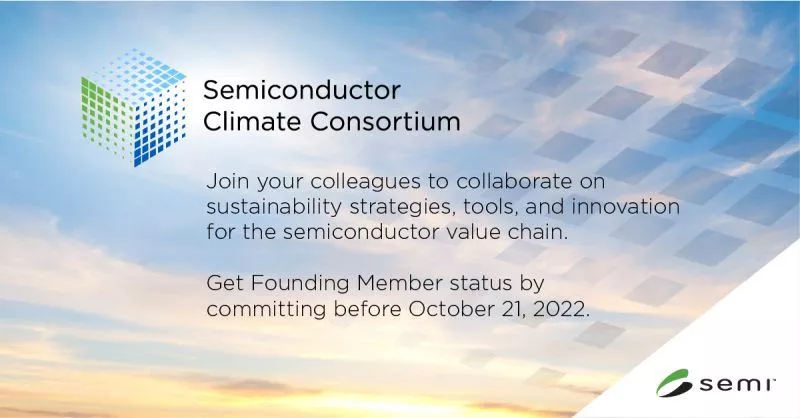
To accelerate efforts to reduce the climate impact of the semiconductor value chain, SEMI members from the equipment, materials and service sectors, as well as several device manufacturers are forming the Semiconductor Climate Consortium (SCC).
The SCC aims to leverage the combined resources of its members to speed sustainability innovations, develop and adopt standards and processes, demystify current schemes for calculating carbon emissions reductions, and share ways to meet carbon emissions disclosure requirements within the semiconductor value chain. Once formed, the newly elected SCC Governing Council (GC) will assess resources and identify priorities.
SEMI invites organizations in the semiconductor value chain to join the Consortium. Why should your company take part? Following are the top 10 reasons.
- Bolster Your Climate Action Plan – The SEMI Sustainability Advisory Council has identified many non-competitive actions that will help participating members strengthen their climate action materiality and strategy. The team building the foundation of the Semiconductor Climate Consortium has identified strategies and priorities from a long list of potential deliverables and narrowed the list to work streams the SCC can adopt and turn into action – actions that can help your own climate action plan.
- Join a Community of Experts – The Consortium consists of a growing community of experts that will join forces to tackle climate issues in the value chain. Each member brings their expertise and perspectives to contribute to developing sustainability solutions faster.
- Collaborate to Help Solve Common Challenges – Scope 3 emissions relate to sources of an organization's indirect emissions across its value chain*. They include sources such as all purchased goods and services, travel and commuting, waste disposal, transport and distribution, use of sold products, investments, leased assets and franchises. Importantly, Scope 3 emissions illustrate the dependency of companies across the value chain on transparency and analytics both upstream and downstream to accurately assess their overall carbon footprint. The Consortium will work toward enhancing these practices collaboratively.
- Define the Semiconductor Value Chain’s Carbon Footprint – Be part of a group that has already begun to define the semiconductor industry value chain’s carbon footprint as a baseline for action.

- Define Industry Value Chain Climate Action Deliverables – The SCC Working Groups will help define the value chain’s deliverables for reducing its climate impact and establish objectives for improvement. The effort will help member companies better understand their role, providing clarity into their individual climate impact and necessary improvements.
- Access Value Chain Trends and Statistics – The Consortium gathers and shares credible climate change analytics, trends and statistics that highlight the urgency the industry value chain faces in alleviating its climate impact.
- Better Evaluate Vendors with Green Component Scoring – The SAC is developing an Equipment Green Score to help fab managers improve its evaluation of vendors in order to make sustainable purchasing decisions, which is now an official SEMI Standards Task Force titled Environmental Performance Rating (EPR).
- Influence Decisions to Launch New Projects – The Consortium’s flexible governance allows the launch of new initiatives and working groups proposed by members. New working groups consisting of a diversity of ideas from members can help accelerate the industry’s value chain progress towards greater sustainability.
- Speed and Scale Climate Change Action – The Consortium’s global reach will enable it to scale its innovation and deployment of sustainability solutions around the world. With the full commitment of our value chain, the Consortium has the ability to speed up deployment of climate solutions and scale them to make meaningful and lasting change.
- Give the Semiconductor Industry Value Chain a Bigger Voice – There’s strength in numbers. As the Consortium grows, it will become a united, engaged collaborative effort that can help influence broader climate change initiatives in the value chain around the world.
*Source: Greenhouse Gas Protocol
John Golightly is Sr. Director of Sustainability and Global Environment, Health and Safety at ASM International, and chair of the SAC Climate Working Group.
Related blog: SEMI Invites Industry Stakeholders to Join New Semiconductor Climate Consortium as Founding Members